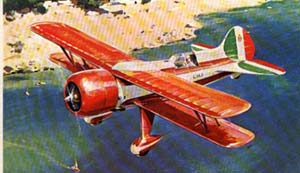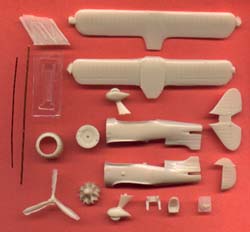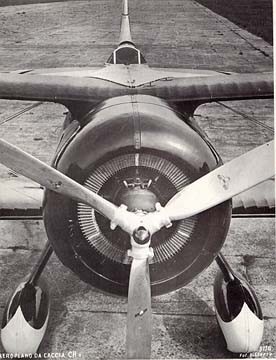Dujin 1/72 Caproni Ch.1 |  | History Toward the end of 1933 the decision was made at Caproni to change their image from that of a conservative maker of bombers and observation planes by adding a fighter to their product line. Thus in early 1934 a study was begun to design a single seat, biplane fighter that was better than the Fiat CR.32, which was just entering service with the Regia Aeronautica, having first flown in April of 1933. Caproni hoped to participate in the next fighter competition for the follow-on to the CR.32 with their new design. Antonio Chiodi, Caproni's chief engineer headed up the study himself. For this product Caproni changed their product designator from "Ca." to "CH" to signify the importance they attached to their new direction. The CH.1 prototype first flew in May of 1935, by which time the Air Force was fully equipped with CR.32s. A 780hp Gnome-Rhone 14Kfs 14 cylinder, air cooled, two-row, radial engine provided the power for the CH.1. Engineer Piero Magni designed a long-chord cowling, based on NACA research, to enclose the engine. Armament was to be two 7.7 mm machine guns, in the fuselage, synchronized to fire through the propeller. The structural heart of the design was a radial truss athwart the center of the airplane that carried the engine mounts, the undercarriage and the four wing spars as well as the fuselage truss, which extended back to the rudder post. The fuselage was clad in aluminum skin for streamlining but the wings and empennage were conventionally fabric covered. The fixed undercarriage was enclosed in good looking, racer-style, wheel pants. Initial flight test results were very promising. The airplane was faster, climbed more quickly and had a higher ceiling than the CR.32; handling was the equal of the Fiat and maintenance was much simpler and easier to perform. Development was expected to push performance even higher to make the airplane a strong contender in the next fighter purchase competition. Lamentably the airplane was heavily damaged when it flipped over onto its back in a landing accident. Caproni determined the airplane was too damaged for economical rebuild and, disheartened, abandoned the whole project. Although it was a fighter prototype the CH.1 looks more like a "Golden Age" racer. The pilot's hood even opened like that of many racers being made of two thin pieces of flexible clear plastic that divided at the top center line and slid down into the cockpit side walls. The Kit  This is my first experience with a Dujin resin kit although I've read several reviews of other subjects in BENT THROTTLES the journal of the IPMS-UK Race & Record Planes SIG. The kit parts are wrapped in an A-4 size copy of Harry Robinson's beautiful four-view drawing, from Le Fana noted below, which is itself wrapped in a half A-4 sheet displaying the kit number - DA 72184 - and the subject and scale and all of this is sealed in a plastic envelope. There are 17 cast resin parts of medium to good, but not great, quality having large films of flash surrounding them all. Two very clouded and useless vac-formed canopies are included along with two short lengths of airfoil cross-section copper rod of different chords. There are no instructions; just the four-view with a list of three references and color notes. There are no decals. This is my first experience with a Dujin resin kit although I've read several reviews of other subjects in BENT THROTTLES the journal of the IPMS-UK Race & Record Planes SIG. The kit parts are wrapped in an A-4 size copy of Harry Robinson's beautiful four-view drawing, from Le Fana noted below, which is itself wrapped in a half A-4 sheet displaying the kit number - DA 72184 - and the subject and scale and all of this is sealed in a plastic envelope. There are 17 cast resin parts of medium to good, but not great, quality having large films of flash surrounding them all. Two very clouded and useless vac-formed canopies are included along with two short lengths of airfoil cross-section copper rod of different chords. There are no instructions; just the four-view with a list of three references and color notes. There are no decals. The parts match Harry Robinson's drawing perfectly but are generally a little ragged and will require a lot of preparation work - filling, filing, sanding, priming; and then doing it all over again a couple of times. The fuselage is in halves with only a separate seat and instrument panel provided for interior detail; so you get to design your own interior. The wings and tailplane are each cast in one piece with delightlfully thin trailing edges. The separate rudder is also well cast with a thin trailing edge. Many small details and one large one are not provided. The big detail that's missing is the large annular oil cooler, shown in the photo, that sits inside the cowling in front of the engine. I have not tried it yet but it looks like a cooler from a "Claude" or an "Oscar I" can be adapted to the CH.1. The windscreen/canopy will be the hardest part to correct as it is not only clouded but is of the wrong lateral cross-section so there's no point in try to polish it. An idea of the correct cross-section can be gotten from the drawing but you really need to look at the color rendering at the head of this review to understand that the sliding side panels cannot have hard edged kinks in them. I'll tape the fuselage halves together and glue a block of Bass (Lime) wood in place with Elmer's white glue and carve, file and sand it to the correct outline and cross-section. This will then be the male mold for vac-forming a usable windscreen/canopy. Conclusion  This one is not for beginners or for the faint of heart; it'll take a lot of work and a fair bit of time but you can get a good result because the outline and dimensions are quite acceptable. The kit's engineering and quality are not Tamiya's but the subject makes up for any such shortcomings and it is accurate. The only real difficulty is with the windscreen/canopy but any persistent modeler can overcome this. When you finish you'll have a beautiful "Golden Age" racer -Oops! - I mean fighter prototype looking lovely in its red, white and green livery. You'll have to scrounge a pair of House of Savoy crests for the rudder and a pair of "CH.1"s for the fuselage. I don't know if anyone in North America handles the Dujin line of kits, which are mostly of esoteric subjects without a large market appeal. A listing of 20 new releases from Dujin appears in the June issue of Scale Aviation Modeller International (SAMI); the CH.1 is amongst them. Friend Charley Schaaf bought the review kit from Hannant's for about 18 pounds Sterling, including p&p, and sold it to me for the same price with the proviso that if I did not have it finished within one year I had to give it back with no refund - talk about motivation! Another release in this new batch that appeals to me is the DeHavilland D.H.71 Tiger Moth monoplane racer - that's the kind of subject done by Dujin and good for them for doing so. This one is not for beginners or for the faint of heart; it'll take a lot of work and a fair bit of time but you can get a good result because the outline and dimensions are quite acceptable. The kit's engineering and quality are not Tamiya's but the subject makes up for any such shortcomings and it is accurate. The only real difficulty is with the windscreen/canopy but any persistent modeler can overcome this. When you finish you'll have a beautiful "Golden Age" racer -Oops! - I mean fighter prototype looking lovely in its red, white and green livery. You'll have to scrounge a pair of House of Savoy crests for the rudder and a pair of "CH.1"s for the fuselage. I don't know if anyone in North America handles the Dujin line of kits, which are mostly of esoteric subjects without a large market appeal. A listing of 20 new releases from Dujin appears in the June issue of Scale Aviation Modeller International (SAMI); the CH.1 is amongst them. Friend Charley Schaaf bought the review kit from Hannant's for about 18 pounds Sterling, including p&p, and sold it to me for the same price with the proviso that if I did not have it finished within one year I had to give it back with no refund - talk about motivation! Another release in this new batch that appeals to me is the DeHavilland D.H.71 Tiger Moth monoplane racer - that's the kind of subject done by Dujin and good for them for doing so. References -
L'Album du fanatique de L'Aviation, No.59 of October 1974* -
Air International, Vol. 8, No.6 -
Italian Civil and Military Aircraft 1930/45, J. Thompson *I was extremely fortunate to have purchased a collection of Le Fanas , Nos. 4 through 170, a couple of years ago and so had this issue available to me. The lead illustration above is cropped from the cover illustration of that issue as is the photo of the oil cooler. | 









|
 This is my first experience with a Dujin resin kit although I've read several reviews of other subjects in BENT THROTTLES the journal of the IPMS-UK Race & Record Planes SIG. The kit parts are wrapped in an A-4 size copy of Harry Robinson's beautiful four-view drawing, from Le Fana noted below, which is itself wrapped in a half A-4 sheet displaying the kit number - DA 72184 - and the subject and scale and all of this is sealed in a plastic envelope. There are 17 cast resin parts of medium to good, but not great, quality having large films of flash surrounding them all. Two very clouded and useless vac-formed canopies are included along with two short lengths of airfoil cross-section copper rod of different chords. There are no instructions; just the four-view with a list of three references and color notes. There are no decals.
This is my first experience with a Dujin resin kit although I've read several reviews of other subjects in BENT THROTTLES the journal of the IPMS-UK Race & Record Planes SIG. The kit parts are wrapped in an A-4 size copy of Harry Robinson's beautiful four-view drawing, from Le Fana noted below, which is itself wrapped in a half A-4 sheet displaying the kit number - DA 72184 - and the subject and scale and all of this is sealed in a plastic envelope. There are 17 cast resin parts of medium to good, but not great, quality having large films of flash surrounding them all. Two very clouded and useless vac-formed canopies are included along with two short lengths of airfoil cross-section copper rod of different chords. There are no instructions; just the four-view with a list of three references and color notes. There are no decals.  This one is not for beginners or for the faint of heart; it'll take a lot of work and a fair bit of time but you can get a good result because the outline and dimensions are quite acceptable. The kit's engineering and quality are not Tamiya's but the subject makes up for any such shortcomings and it is accurate. The only real difficulty is with the windscreen/canopy but any persistent modeler can overcome this. When you finish you'll have a beautiful "Golden Age" racer -Oops! - I mean fighter prototype looking lovely in its red, white and green livery. You'll have to scrounge a pair of House of Savoy crests for the rudder and a pair of "CH.1"s for the fuselage. I don't know if anyone in North America handles the Dujin line of kits, which are mostly of esoteric subjects without a large market appeal. A listing of 20 new releases from Dujin appears in the June issue of Scale Aviation Modeller International (SAMI); the CH.1 is amongst them. Friend Charley Schaaf bought the review kit from Hannant's for about 18 pounds Sterling, including p&p, and sold it to me for the same price with the proviso that if I did not have it finished within one year I had to give it back with no refund - talk about motivation! Another release in this new batch that appeals to me is the DeHavilland D.H.71 Tiger Moth monoplane racer - that's the kind of subject done by Dujin and good for them for doing so.
This one is not for beginners or for the faint of heart; it'll take a lot of work and a fair bit of time but you can get a good result because the outline and dimensions are quite acceptable. The kit's engineering and quality are not Tamiya's but the subject makes up for any such shortcomings and it is accurate. The only real difficulty is with the windscreen/canopy but any persistent modeler can overcome this. When you finish you'll have a beautiful "Golden Age" racer -Oops! - I mean fighter prototype looking lovely in its red, white and green livery. You'll have to scrounge a pair of House of Savoy crests for the rudder and a pair of "CH.1"s for the fuselage. I don't know if anyone in North America handles the Dujin line of kits, which are mostly of esoteric subjects without a large market appeal. A listing of 20 new releases from Dujin appears in the June issue of Scale Aviation Modeller International (SAMI); the CH.1 is amongst them. Friend Charley Schaaf bought the review kit from Hannant's for about 18 pounds Sterling, including p&p, and sold it to me for the same price with the proviso that if I did not have it finished within one year I had to give it back with no refund - talk about motivation! Another release in this new batch that appeals to me is the DeHavilland D.H.71 Tiger Moth monoplane racer - that's the kind of subject done by Dujin and good for them for doing so. 








